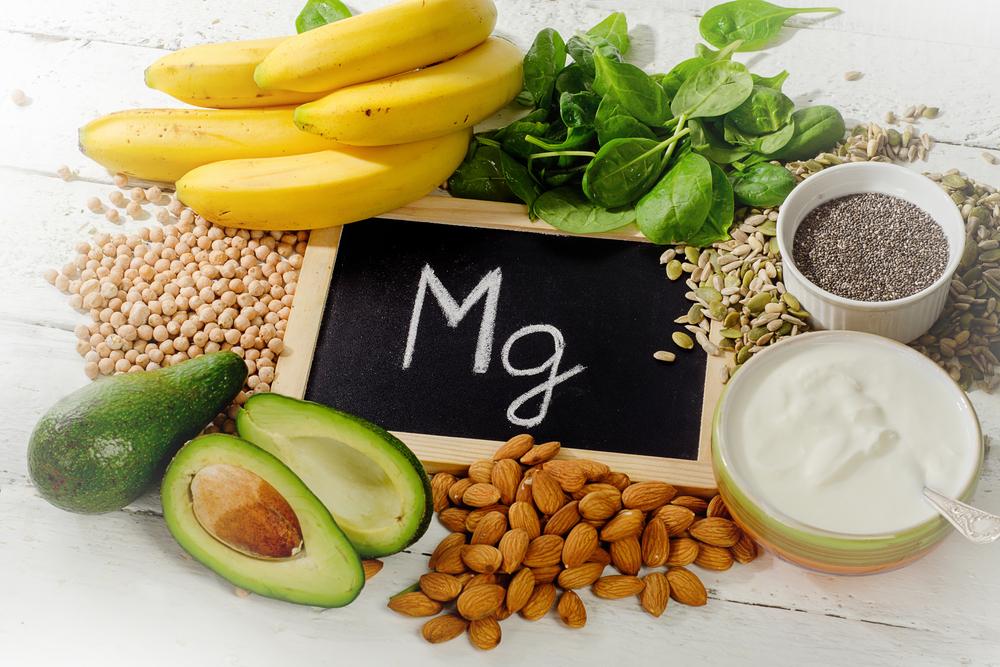One of the most abundant minerals in the body along with calcium and phosphorus, magnesium is essential to bodily function. Whilst there is some disagreement on the numbers, anywhere from 60-70% of the body’s magnesium is found in bone; the rest is in cellular fluid and soft tissue.
Absorbed primarily in the small intestine,it soon finds its way to regulate muscle contraction (including the heart),blood pressure, insulin metabolism and to synthesise DNA, RNA and proteins! Not only that but it plays a key role in the nervous system for nerve transmission and neuromuscular coordination. It has also been found to protect against excitotoxicity.
Rarely heralded for these qualities, it is an easy nutrient to miss; several human nutrition textbooks certainly do. So, let us explore this trusty element (Mg)in a little more detail and how it is particularly important to overall health.
What is Magnesium?
Magnesium is a chemical element; it is found in the Earth’s crust and found dissolved in sea water with sodium and chlorine. It is essential to all cells in the human body and activates some 300 enzymatic reactions necessary for metabolism. It interacts with ATP (energy carrying molecule), DNA and RNA.
Plants too require magnesium to synthesise chlorophyll (the green pigment found in plants), which is essential for photosynthesis.
Magnesium helps promote the absorption and metabolism of other minerals such as calcium, phosphorus, sodium and potassium. Not only that but it also plays a role in the utilisation of B-complex vitamins and vitamins C and E.
Magnesium is the second most abundant mineral in your dog’s body, after potassium. It has a role throughout the body, so let’s start at the top.
Signs of Magnesium deficiency
Possible signs your pet is deficient:
- Muscle cramps
- Seizures
- Nervousness
- Low stress tolerance
- Anxiety
- Depression
- ‘Behavioural issues’
- GI upset (often constipation with low levels)
- Loss of appetite and nausea
- Pancreatic dysfunction decreased glucose tolerance
- Fatigue
- Heart arrhythmia
- Hypertension
- Urinary disorders in cats
The Role of Magnesium in Neurological Disorders
Magnesium is essential in nerve transmission and neuromuscular conduction.
It is also thought to be protective of excessive excitation that can lead to neuronal cell death. What this means is, it is thought to be of benefit in cases of chronic pain, anxiety and depression. It’s all to do with neurotransmitters.
Neurotransmitters are in short, the body’s chemical messengers. They are the molecules used by the nervous system to shuttle messages between neurons, and from neurons to glands or muscles. Communication between neurons occurs at tiny gaps called synapses. One neuron (presynaptic neuron) releases a chemical (neurotransmitter) that is received by the other one (post synaptic neuron), which subsequently alters that neuronal function. Receptors can be designated as either excitatory or inhibitory; excitatory if they increase the likelihood of an action potential, and inhibitory if they decrease the likelihood a neuron will fire an action. The body thrives when it is in balance, maintaining homeostasis. Think of it as if you got into the car and just carried on driving, ignoring stop signs, junctions, other cars etc. Chaos would ensue. Inhibitory neurotransmitters are the highway code, stop signs, roundabouts etc; they ensure balance.
There are two particularly relevant neurotransmitters, GABA (gamma-aminobutyric acid) and glutamate. Glutamate is excitatory and GABA is inhibitory. GABA counters Glutamate; they are the ying:yang of neurotransmitters. GABA relaxes and sedates, which is why low levels of GABA are often linked to anxiety or mood disorders (in humans).
Magnesium is thought to modulate glutamatergic neurotransmission. Low magnesium levels have been suggestive of a supportive environment for excitotoxity; in short, there was too much glutamate at the party which resulted in cell death. Not surprisingly, this results in neurological decline/disorder. Magnesium seems to inhibit the receptors which glutamate acts on. Through this mechanism, it is also thought that GABA availability is increased.
Findings here
(Interestingly, the mineral zinc also down regulates glutamate response).
Findings here
In humans, many studies have demonstrated that magnesium is neuroprotective; this is particularly relevant for anxious or fearful dogs.
Findings here
Magnesium and the Heart
Magnesium deficiencies have been linked with cardiovascular disorders, including high blood pressure and abnormal rhythms. There are a number of mechanisms in which magnesium supports heart health and function.
Magnesium naturally competes with calcium which is essential in generating heart muscle contractions. Calcium stimulates the muscle and magnesium counters it; helping them to relax (this is also why magnesium is used in cases of spasms).
When magnesium levels are low, calcium can overstimulate heart muscles causing a rapid or irregular heartbeat. As we have mentioned, magnesium is key to maintaining balance.
Findings here
There are also studies that suggest low levels of magnesium have been linked to low HDL (good) cholesterol, high triglycerides, and total cholesterol. This suggests that magnesium could be protective in cases of heart disease.
Findings here
Magnesium and Oxidative Stress and Free Radicals
Oxidative stress is defined as the imbalance between oxidants and antioxidants; potentially leading to damage. Oxidants are reactive species,and some are free radicals. Reactive species are important in many physiological processes, but the over production can cause problems.
It is thought that magnesium may attenuate free radical production in one of two ways. Firstly, it may directly inhibit free radical production and secondly, it may facilitate the scavenging of free radicals. Low magnesium levels have been linked with reduced antioxidants like glutathione, vitamin C, vitamin E and selenium.
In short, low magnesium has been linked to greater levels of free radical production and low-level production of other antioxidants.
Findings here
Magnesium, Glucose Metabolism, and Insulin Resistance
When food is eaten, it makes its way through the stomach and into the intestines; it is converted into glucose or blood sugar (the body’s fuel). In response, the pancreas produces insulin which helps cells absorb glucose for energy, now, blood sugar levels start to fall. High glucose calls for high levels of insulin and if this is repeated regularly, the body can stop responding to insulin; or stop producing it all together.
Magnesium plays a role in both glucose metabolism and regulating insulin; deficiencies have been linked to insulin resistance and when supplemented, insulin sensitivity has improved.
Interestingly, insulin also regulates there absorption of magnesium in the kidney which can paradoxically further affect magnesium levels. In cases of diabetes, the increased urine volume also dilutes magnesium levels.
Findings here
The take home is that magnesium improves metabolic control.
Magnesium and Bone Health
It wouldn’t be a mineral without the mention of bone health.
Around 60% (give or take) of total Mg is stored in the bone. It provides structure, but as we have established, magnesium has a role in many cellular functions; this is no different for osteoblasts and osteoclasts.
An osteoblast is a cell which secretes the substance of bone; they are responsible for new bone formation. Blast, think explosion of new bone.
An osteoclast is a type of cell that breaks down bone tissue; they are responsible for the maintenance, repair and remodelling of bones. Clast – think cleave, cutting or splitting.
Both are key to bone health; working together they maintain homeostasis. Imbalance in either can result in a range of bone disorders.
Magnesium seems to affect bone health in many ways. When magnesium levels are low in the body, it is mobilised from the bones; low magnesium is linked to low bone density.
It also interacts with other molecules key to bone health; specifically, Vitamin D, parathyroid hormone (PTH) and calcium.
Low levels of magnesium impairs secretion of PTH which can then result in low calcium levels. Reduced PTH can also lead to low levels of Vitamin D.
Interestingly, low Mg promotes oxidative stress and the increase in free radicals potentiate the activity of osteoclasts and depress that of osteoblasts. This imbalance of clasts and blasts also occurs in another pathway, namely because low Mg promotes inflammation; cytokines amplify clast behaviour whilst inhibiting blast behaviour.
Findings here
Magnesium and Muscle Function
As we have explored, magnesium is essential in energy metabolism and normal muscle function.
Studies have found that Mg may improve exercise performance by enhancing glucose availability in the brain, muscles,and blood. Mg status has also been linked with muscle performance, muscle power, improved gait and speed.
Findings here
As you can see, magnesium is essential in many functions in the body. Low levels will present in many ways.
What causes Magnesium Depletion?
It stands to reason that a diet low in magnesium would contribute to low levels; but this is for a number of reasons.
Depleted soils affect the nutrients found in foods; magnesium is also refined out of many food products during processing. Not only that but phytates and oxalic acid bind this mineral and interfere with the absorption. The primary sources of magnesium include whole grains, beans, seeds, nuts and fresh green vegetables, but phytates and oxalic acid are found in precisely these foods.
Fluoride is also thought to bind and produce insoluble complexes, inhibiting absorption of magnesium found in tap water.
Findings here
Calcium also competes with the same pathway as magnesium, so high levels of calcium can also interfere with absorption; this can be through diet or with supplementation.
It is also thought that Vitamin D stimulates intestinal absorption of Mg, but interestingly, Mg is a key player in the conversion of Vitamin D to its biologically active form. They certainly seem to have a coordinated interaction. It can be considered a chicken-egg scenario. Did low Vit D reduce Mg absorption, or did low Mg reduce Vit D conversion?
As magnesium is primarily absorbed in the small intestine, gastrointestinal malabsorption can result in depletion. Not only that, but low levels are noted incases of prolonged or severe diarrhoea. Depressed levels are also noted in cases of prolonged exercise, heat and stress. The pH found in the GI tract can also affect magnesium solubility.
Findings here
Most interestingly, certain medications can affect magnesium status:
Cyclosporine (has been used in cases of IBDin dogs)
Findings here
Pentamidine
Cisplatin
Findings here
Omeprazole (cases of gastroenteritis)
Findings here
Food Sources of Magnesiu
Spinach – 157mg of magnesium per cup (cooked)
Swiss Chard – 151mg per cup (cooked)
Kale – 74mg per cup (cooked)
Pumpkin Seeds – 156mg per 1oz handful
Tuna – 109mg per 6oz fillet
Feeding a species appropriate diet with raw bones (ground or otherwise) or a very high quality, well produced and pure bonemeal, can also add the best form of magnesium to your pet’s diet.
Supplementation:
Be mindful of how magnesium interacts with other molecules like calcium, PTH and Vitamin D. There are also concerns around Mg supplementation in cases of chronic kidney disease because of the risk of hypermagnesemia due to impaired renal excretion of Mg.
In humans, it is considered that strenuous activity increases magnesium losses through urine and sweat; as dogs don’t sweat this may affect the numbers, but it is argued that magnesium requirements can increase anywhere between 10 and 20%. This may be a relevant consideration for the working dog.
Findings here
It is clear that magnesium plays a number of essential roles in the body; predicted to be upwards of 80% of it’s metabolic functions. Low levels have been linked with anxiety and mood disorders, cardiovascular issues, a range of metabolic dysfunctions and muscular performance. Not only that but it plays a role in oxidative stress and inflammation. Magnesium depletion can occur from low dietary intake, but processing has significantly affected the nutrient quantity and quality found in many foods. This is further compounded by oxalates and phytates, which are found in many of the high Mg foods. Malabsorption can affect overall Mg levels, along with a range of medications and it’s interactions with other molecules like calcium, PTH and Vitamin D should be considered in supplementation. Pay special attention in cases of chronic kidney disease.
As always, testing is relevant and seeing a health care practitioner before supplementing is best. If you would like to learn more about what we offer. Check us out.
Consultations
Thanks for reading.
MPN Team x




















